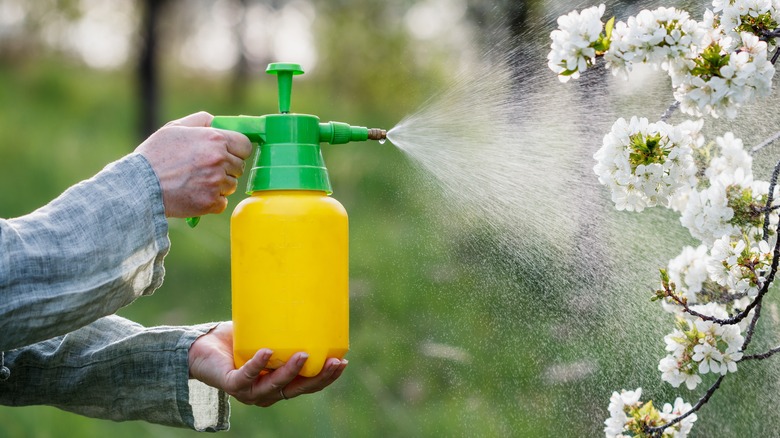The Best Time Of Year To Spray Fruit Trees To Prevent Worms In Your Fruit
No one wants to pick a juicy-looking piece of fruit only to find it's already been eaten by a worm. Spraying fruit trees at the right time will drastically limit the chances of an infestation. Early spring is the best time to spray your trees to prevent worms. Popular tree pests like the peachtree borer are attracted to wounded trees and further contribute to the decline of a tree and often prevent them from supplying fruit. If you have fruit trees, it's important to proactively treat them for pests, especially if the tree is damaged, injured, or recovering from a previous infestation.
A routine schedule of spraying pesticides or natural alternatives is critical for protecting your tree. Though there are other preventative measures you can take, nothing beats spraying your trees before the insects emerge during the warmer months. Applying pest protection before the worms can burrow into your trees will ensure a happier and healthier harvest come fall.
When to spray your fruit trees for the best pest control
Though you won't harvest fruits until the end of summer or fall, you have to think ahead. Pests like codling moths and boring insects emerge in June and continue to thrive until fall. After they've hatched, these insects burrow into the tree bark where their presence drastically impacts the health and structure of a tree. Spraying your trees in early spring is the best way to prevent pests from infesting your fruit trees once they hatch.
There are many pesticides on the market suitable for fruit trees and the insect species they tend to attract. It's also possible to keep pests and diseases at bay with a DIY solution. Spray your trees once the temperature begins to heat up and the danger of frost is gone. For many, this may be mid April to early May. From then, your spraying schedule will depend on your particular fruit tree and its life cycle. For example, apple trees will need to be sprayed again in the summer and fall.
Other ways to banish worms
Using insecticide is an effective way to protect your fruit trees against worms, but there are more ways you can reduce your risk of an infestation. First, make sure the ground is free from fruit. When fruit drops and is left to decay on the soil, it will attract insects. Picking up fruit and destroying it is especially important during the months of June and July as typically, the fallen fruit is typically infested with worms.
You can also protect your trees with trunk banding, a process that consists of wrapping a trunk with corrugated cardboard or burlap. The textured material will serve as a trap for larvae that you can then relocate or destroy. Cardboard bands should be about six inches wide and should be wrapped around the tree with the corrugated side against the bark. Place the bands from the base up to 3 ⅓ feet. Secure the bands with zip ties or something else that will keep the bands close to the tree.
Planting daffodil bulbs nearby will also protect fruit trees from pests. Daffodils are not only beautiful, but they also make suitable companion plants for fruit trees. They're poisonous to pests and attract pollinators that will further benefit your tree. Create your own tree guild by planting daffodils in a ring around the base.


